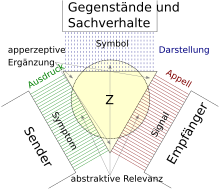You can help expand this article with text translated from the corresponding article in German. (January 2022) Click for important translation instructions.
|

The organon model is a model of communication by German psychologist and linguist Karl Ludwig Bühler (1879 – 1963). It was published in German in 1934. and not translated into English until 1990. In it he defined the functions of communication according to which linguistic communication can be described. Bühler's work influenced the communication model of Roman Jakobson.
Buhler's model also apparently influenced Lev Vygotsky who, in discussing memory and goal-directed learning, wrote: "According to K. Buhler, speech thinks for us."
Bühler identified the following three communicative functions:
- the expressive function (Ausdrucksfunktion)
- the representation function (Darstellungsfunktion)
- the conative function (Appellfunktion, i.e. appealing function).
Background
Karl Bühler used the Cratylus of Plato as the basis for his remarks. Here, Socrates refers to the word as an Ancient Greek: ὄργανον, romanized: órganon, lit. 'instrument, tool, organ', and thus to language as a whole as a tool, with which a person can communicate something to others about things. Bühler described this relationship as a 'three-foundations scheme': oneself - to the other - about things (einer - dem anderen - über die Dinge).
Bühler's organon model criticized the material thinking of behaviorism, which according to him had renewed the "flatus-vocis nominalism of the incipient Middle Ages in modern form."
As a semiotic model
Hartmut Stöckl described the Organon model as a semiotic model, comparing it to Aristotle's triad of pathos, logos, and ethos. He wrote:
model acknowledges “the essential rhetorical fact that any sign use must in effect express the ethos of the rhetor, represent their rational take on the world (logos) and appeal to the emotional mindset of an envisaged audience (pathos).”
— Stöckl, Tracing the shapes of multimodal rhetoric
The model has been compared to Kress's semiotic model.
References
- ^ Karl Bühler (1934). Sprachtheorie. Oxford: Fischer.
- ^ Karl Bühler (1990) . The Theory of Language: The Representational Function of Language (Sprachtheorie). Translated by Donald Fraser Goodwin. Amsterdam: John Benjamin. ISSN 0168-2555.
- "Kommunikation im Wandel –Vergangenheit und Zukunft im Blick". www.tips.at. May 21, 2015.
- Lev Vygotsky (1960). Проблема развития и распада высших психических функций [On the development and degradation of the higher psychological functions].
- Stöckl, Hartmut (2023-02-06). "Bold and impactful: a reappraisal of Gunther Kress's (social) semiotic legacy in the light of current multimodality research". Text & Talk. doi:10.1515/text-2021-0189. ISSN 1860-7349.
- Pflaeging, Jana; Stöckl, Hartmut (August 2021). "Tracing The Shapes of Multimodal Rhetoric: Showing the Epistemic Powers of Visualization". Visual Communication. 20 (3): 397–414. doi:10.1177/14703572211010370. ISSN 1470-3572.
This article relating to communication is a stub. You can help Misplaced Pages by expanding it. |